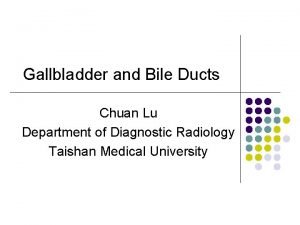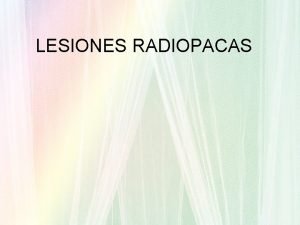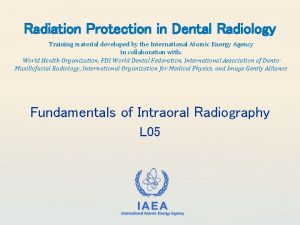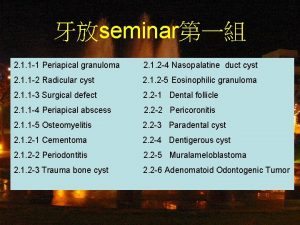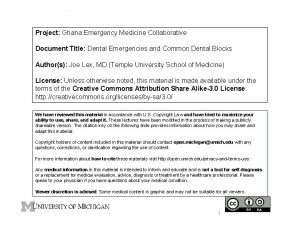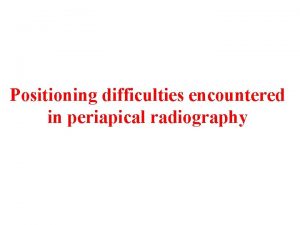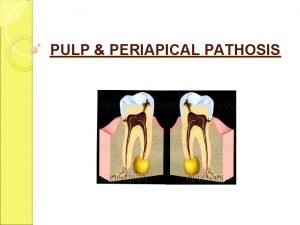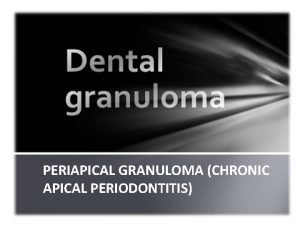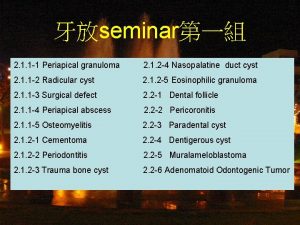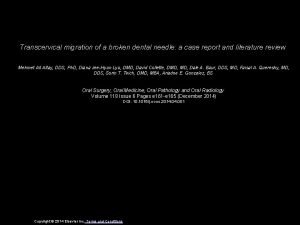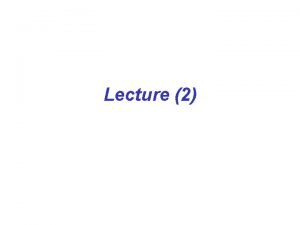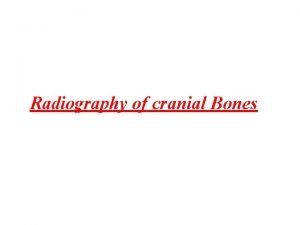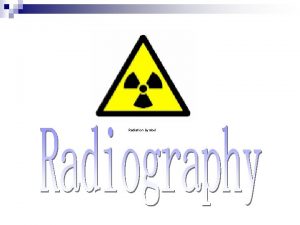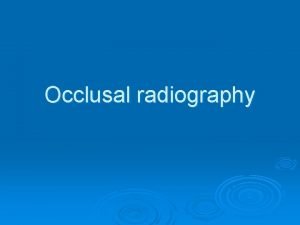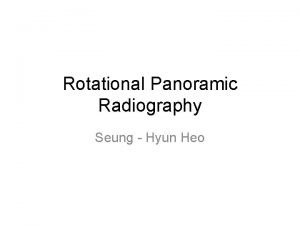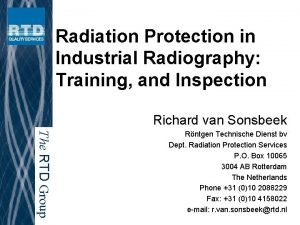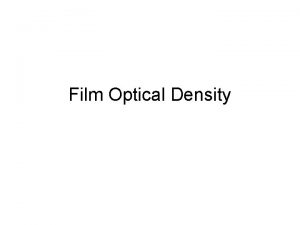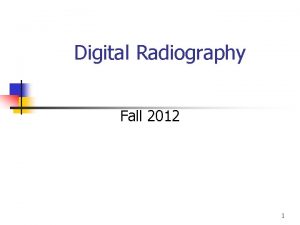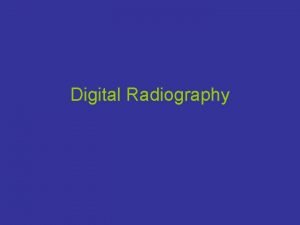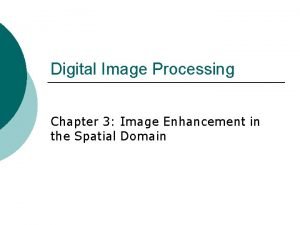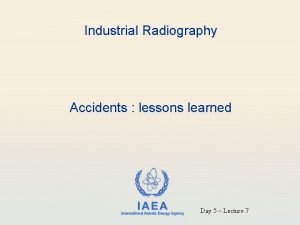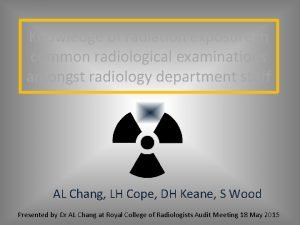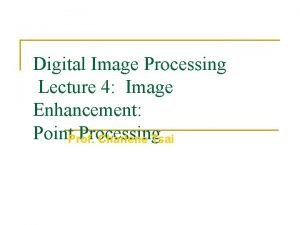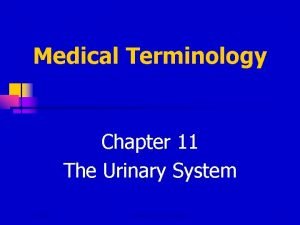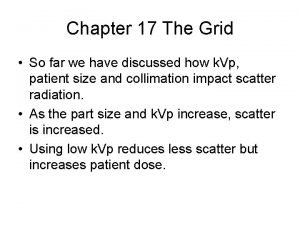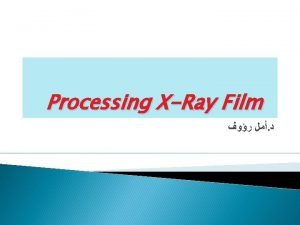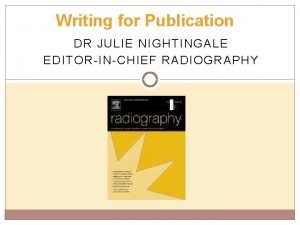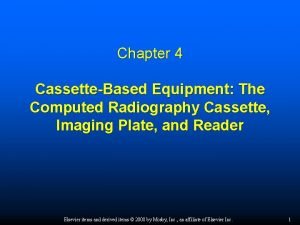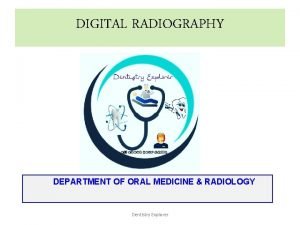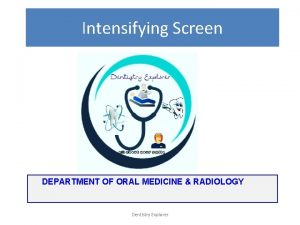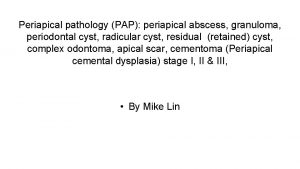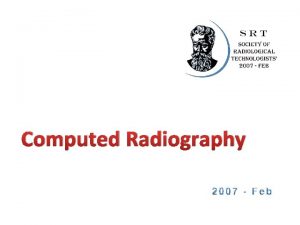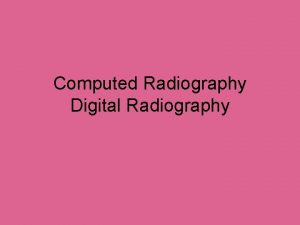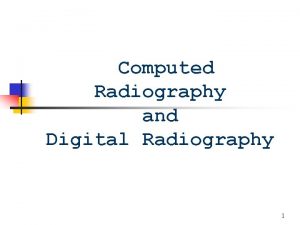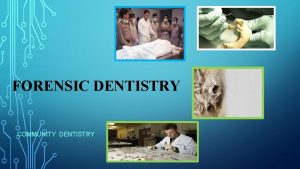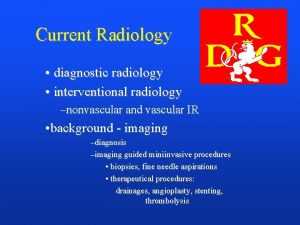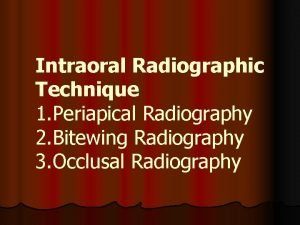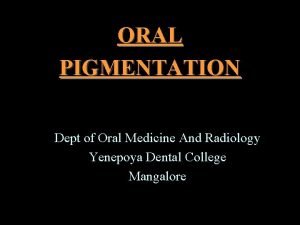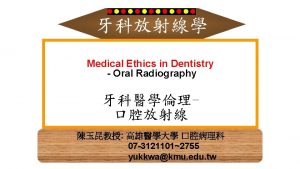Periapical radiography DEPARTMENT OF ORAL MEDICINE RADIOLOGY Dentistry
















































- Slides: 48

Periapical radiography DEPARTMENT OF ORAL MEDICINE & RADIOLOGY Dentistry Explorer

• Periapical radiography describes intraoral techniques designed to show individual teeth and the tissues around the apices. Each film usually shows two to four teeth and provides detailed information about the teeth and the surrounding alveolar bone. Dentistry Explorer

• Main indications • The main clinical indications for periapical radiography include: • Detection of apical infection/inflammation • Assessment of the periodontal status • After trauma to the teeth and associated alveolar bone • Assessment of the presence and position of unerupted teeth Dentistry Explorer

• • • Assessment of root morphology before extractions • During endodontics • Preoperative assessment and postoperative appraisal of apical surgery • Detailed evaluation of apical cysts and other lesions within the alveolar bone • Evaluation of implants postoperatively. Dentistry Explorer

• Ideal positioning requirements • The ideal requirements for the position of the film packet and the X-ray beam, relative to a tooth, are shown in Figure 8. 1. They include: • • The tooth under investigation and the film • packet should be in contact or, if not feasible, • as close together as possible • • The tooth and the film packet should be • parallel to one another Dentistry Explorer

The film packet should be positioned with its long axis vertically for incisors and canines, and horizontally for premolars and molars with sufficient film beyond the apices to record the apical tissues • The X-ray tubehead should be positioned so that the beam meets the tooth and the film at right angles in both the vertical and the horizontal planes • The positioning should be reproducible. Dentistry Explorer

Dentistry Explorer

Basic principles of periapical radiography • • The anatomy of the teeth and jaw The head position X-ray beam angulation Point of entry of the x-ray beam Dentistry Explorer

• Anatomical consideration • Location of the long axes of the teeth • Location of the apices of the teeth Dentistry Explorer

Dentistry Explorer

Dentistry Explorer

Dentistry Explorer

Dentistry Explorer

Location of the apices of teeth Dentistry Explorer

Dentistry Explorer

Head position for maxilla Dentistry Explorer

Head position for mandible Dentistry Explorer

X-ray beam angulation Dentistry Explorer

X-ray beam horizontal angulation Dentistry Explorer

Point of entry Dentistry Explorer

Radiographic techniques • The anatomy of the oral cavity does not always • allow all these ideal positioning requirements to • be satisfied. In an attempt to overcome the problems, • two techniques for periapical radiography • have been developed: • • The paralleling technique • • The bisected angle technique Dentistry Explorer

Paralleling technique • • • Theory 1. The film packet is placed in a holder and positioned in the mouth parallel to the long axis of the tooth under investigation. 2. The X-ray tubehead is then aimed at right angles (vertically and horizontally) to both the tooth and the film packet. 3. By using a film holder with fixed film packet and X-ray tubehead positions, the technique is reproducible. Dentistry Explorer

• • This positioning has the potential to satisfy four of the five ideal requirements mentioned earlier. However, the anatomy of the palate and the shape of the arches mean that the tooth and the film packet cannot be both parallel and in contact. As shown in Figure 8. 2, the film packet has to be positioned some distance from the tooth. Dentistry Explorer

Dentistry Explorer

• • To prevent the magnification of the image that this separation would cause, a parallel, nondiverging, X-ray beam is required (see Fig. 8. 3). As explained in Chapter 5, this is achieved usually by having a large focal spot to skin distance, by having a long spacer cone or beam-indicating device (BID) on the X-ray set. Dentistry Explorer

Magnification of the image Dentistry Explorer

Dentistry Explorer

Film holding device Dentistry Explorer

Dentistry Explorer

Bisected angle technique • • • Theory The theoretical basis of the bisected angle technique is shown in Figure 8. 13 and can be summarized as follows: 1. The film packet is placed as close to the tooth under investigation as possible without bending the packet. 2. The angle formed between the long axis of the tooth and the long axis of the film packet is assessed and mentally bisected. Dentistry Explorer

• • 3. The X-ray tubehead is positioned at right angles to this bisecting line with the central ray of the X-ray beam aimed through the tooth apex. 4. Using the geometrical principle of similar triangles, the actual length of the tooth in the mouth will be equal to the length of the image of the tooth on the film. Dentistry Explorer

• • • Vertical angulation of the X-ray tubehead The angle formed by continuing the line of the central ray until it meets the occlusal plane determines the vertical angulation of the X-ray beam to the occlusal plane (see Fig. 8. 13). Note: These vertical angles are often quoted but inevitably they are only approximate. Patient differences including head position, and individual tooth position and inclination mean that each positioning should be assessed independently. The vertical angulations suggested should be taken only as a general guide. Dentistry Explorer

Dentistry Explorer

Horizontal angulation of the X-ray tubehead In the horizontal plane, the central ray should be aimed through the interproximal contact areas, to avoid overlapping the teeth. The horizontal angulation • is therefore determined by the shape of the • arch and the position of the teeth (see Fig. 8. 14). • • Dentistry Explorer

Determined by shape of the arch and the position of teeth Correct horizontal angulation Dentistry Explorer

Incorrect horizontal vertical angulation Dentistry Explorer

Positioning techniques • • • The bisected angle technique can be performed either by using a film holder to support the film packet in the patient’s mouth or by asking the patient to support the film packet gently using either an index finger or thumb. Using a film holder is the recommended technique to avoid irradiating the patient’s fingers. However, using the finger is still widely used and both techniques are described and illustrated. Dentistry Explorer

Dentistry Explorer

The appropriate sized film packet is positioned and orientated in the mouth as shown in with about 2 mm extending beyond the incisal or occlusal edges, to ensure that all of the tooth will appear on the film. The patient is then asked to gently support the film packet using either an index finger or thumb Dentistry Explorer

Effects of incorrect vertical tube head positioning Dentistry Explorer

Foreshortened image caused by projection of central ray from an angle that is too great. Dentistry Explorer

Elongated image caused by projection of central ray from an angle that is too small. Dentistry Explorer

• • Problems posed by mandibular third molars The main difficulty is placement of the film packet sufficiently posteriorly to record the entire third mandibular molar (particularly when it is horizontally impacted) and the surrounding tissues, including the inferior dental canal Dentistry Explorer

• A second film packet is placed in the same • position as before, but the X-ray tubehead is positioned further posteriorly aiming forwards • to project the apex of the third molar on to the • film. (With this positioning, the crowns of the • second and third molars will be overlapped Dentistry Explorer

• Note: The vertical angulation of the X-ray tubehead is the same for both projections. Dentistry Explorer

• Placing the film packet flat in the mouth (in • the occlusal plane) so it does not touch the palate, and applying the principles of the • bisected angle technique — the long axes of the • tooth and film packet are assessed and the X-ray • tubehead’s position modified accordingly, as • shown in Figure Dentistry Explorer

Diagram showing the relative position of the X-ray beam to the maxillary molar and film, when the film is placed in the occlusal plane. Note: The length of the image of the tooth on the radiograph should again equal the length of the tooth in the mouth. However, there will be considerable distortion of the surrounding tissues Dentistry Explorer

conclusion • Periapical radiography is not always as straightforward • in practice as it appears in theory. Although • the paralleling technique should be regarded as • the technique of choice, it is not always possible. • However, a knowledge of theoretical requirements • of imaging enables the clinician to modify • the available techniques to suit individual needs of • patients. Dentistry Explorer
 Oral disease
Oral disease American academy of oral and maxillofacial radiology
American academy of oral and maxillofacial radiology Gallbladder length
Gallbladder length Pubh4401
Pubh4401 Dentistry & oral sciences source
Dentistry & oral sciences source Radiolucido y radiopaco rx
Radiolucido y radiopaco rx Periapical
Periapical Faulty
Faulty Radiolucence
Radiolucence Classification of periradicular diseases
Classification of periradicular diseases Periapical
Periapical Periapical
Periapical Pulp pathosis
Pulp pathosis Periapical granuloma
Periapical granuloma Lateral periodontal cyst
Lateral periodontal cyst Oral medicine
Oral medicine Faculty of medicine mcgill
Faculty of medicine mcgill Department of medicine solna
Department of medicine solna Recumbent position
Recumbent position Smv sinuses
Smv sinuses Radiography cordon off distance formula
Radiography cordon off distance formula Gurney-mott theory radiography
Gurney-mott theory radiography Dental radiographic interpretation ppt
Dental radiographic interpretation ppt Reverse towne projection
Reverse towne projection Combining spatial enhancement methods
Combining spatial enhancement methods Types of occlusal radiograph
Types of occlusal radiograph Is emphysema additive or destructive
Is emphysema additive or destructive Focal trough in panoramic radiography
Focal trough in panoramic radiography Industrial radiography training
Industrial radiography training Optical density formula
Optical density formula Soot and whitewash radiography
Soot and whitewash radiography Filmless radiography
Filmless radiography Sulphonal casset
Sulphonal casset Mask mode radiography
Mask mode radiography Industrial radiography accidents
Industrial radiography accidents Radiography safety precautions
Radiography safety precautions Air gap technique in radiology
Air gap technique in radiology Limitations of radiography
Limitations of radiography Industrial radiography accidents
Industrial radiography accidents Sid and oid
Sid and oid Mask mode radiography
Mask mode radiography Urethrorhagia
Urethrorhagia Rni radiography
Rni radiography Loading bench in darkroom
Loading bench in darkroom Oscillating grid radiography
Oscillating grid radiography Latent image definition
Latent image definition Buccal object rule dental radiography
Buccal object rule dental radiography Radiography
Radiography Cr imaging plate layers
Cr imaging plate layers


